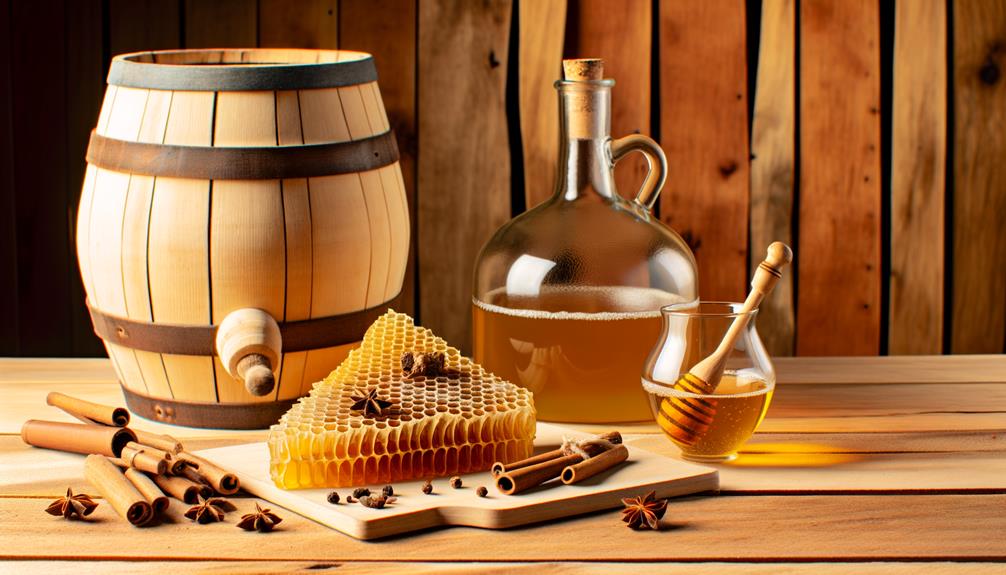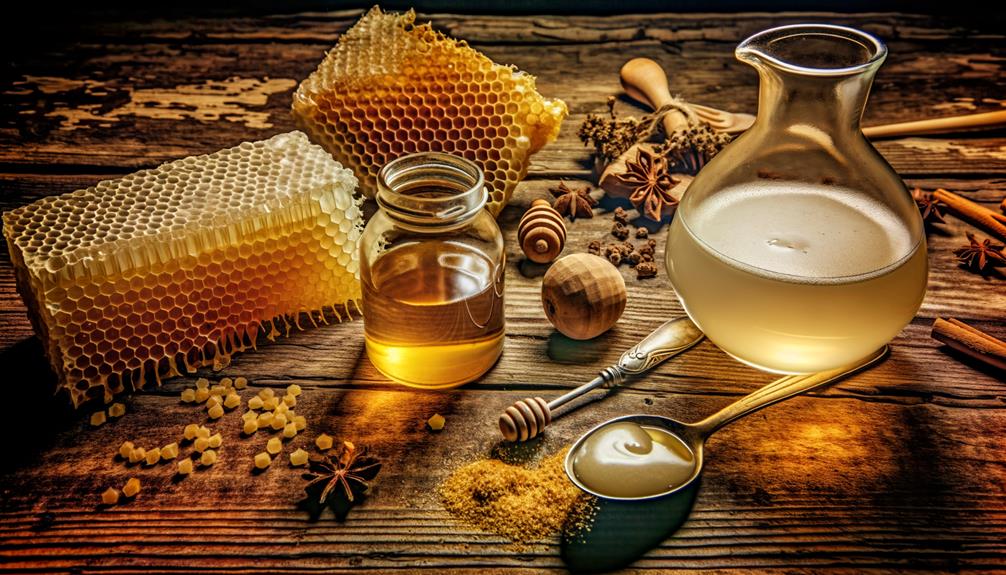Making mead, honey wine of the Vikings, at home is a snap! Mix honey and water, add wine yeast, let it ferment in a glass gallon carboy with an airlock and rubber stopper, you're all set! Don't forget to use fresh ingredients – quality honey, optional fresh fruit, herbs, and filtered water. Control the fermentation temperature, and guarantee aeration for the best results. Bottle it up, store it somewhere cool and dark, and you'll have a brew that would make a Viking proud. Trust me, there's a bunch more to squeeze out of this age-old recipe as you advance.
Mead's Historical Background
Did you know that mead, a beverage enjoyed by various cultures worldwide, has a rich history dating back to ancient times? I'm not just talking about a few hundred years ago, but thousands! The recipe for making mead is pretty simple: honey, water, and yeast. That's it! You'd be surprised to know that our Viking ancestors, renowned for their bravery and seafaring exploits, also harbored a love for this fermented delight.
Now, here's where things get interesting. Historical evidence suggests these Vikings may have consumed mead with potential psychotropic effects. Talk about a party, right? This fascinating factoid is backed by archaeological findings from the Viking and Bronze Age periods. While we're on the subject of names, it's worth mentioning that 'mead' in Nordic folklore sometimes refers to ale or other fermented beverages. So don't be surprised if you come across this during your mead-making adventure.
Mead's discovery was likely accidental, but aren't some of the best things in life unplanned? What's even more, it's believed to have probiotic benefits. That's right! Your love for mead could be contributing to a healthier lifestyle. Now that's a win-win!
Essential Components for Mead
While we've delved into the captivating history of mead, it's time to get practical and discuss the key components you'll need to brew your own at home. For your simple mead recipe, you'll need the following: honey, water, a glass gallon carboy, an airlock, a rubber stopper, and wine yeast.
| Essential Components | Description |
|---|---|
| Honey and Water Mixture | One gallon is ideal. The type and quality of honey impact the flavor. |
| Glass Gallon Carboy | This is where the honey and water mixture will ferment. |
| Airlock and Rubber Stopper | These help control the fermentation process in the carboy. |
The honey and water mixture is essential for any mead recipe. The glass gallon carboy is where the fermentation process takes place. The airlock and rubber stopper are necessary to guarantee proper fermentation. And of course, wine yeast is what gets the fermentation process going.
If you're a beginner, Meadmaking starter kits are a great option. They contain all these essential components and more. With these vital ingredients and tools, you're well on your way to brewing your own mead!
Homemade Mead Preparation Guide

Now that we've gathered all the essential components, let's explore the step-by-step process of preparing homemade mead. We'll start with a gallon batch, using our essential equipment: a one-gallon glass carboy.
First, we'll create a honey water mix. This is the foundation for all mead recipes. We'll simmer filtered water and honey together, adjusting the ratio to meet our sweetness preferences.
Next, we'll introduce our champagne yeast. This yeast is ideal for the fermentation process, as it can handle the high sugar levels in our honey water. After adding the yeast, we'll seal our carboy and let the magic happen.
The fermentation process could take a couple of weeks or even a few months, depending on your flavor customization preferences. Here's a quick rundown:
- Simmer honey and water to create your base
- Add champagne yeast to initiate the fermentation process
- Allow time for fermentation, following your flavor customization preferences
It's a straightforward process to make mead using these steps. But remember, the key to great homemade mead lies in the details. Each step is crucial, and the flavors you choose will make your mead uniquely yours. Happy brewing!
Expert Tips
Let's get into the nitty-gritty of perfecting your mead.
From handpicking the finest ingredients to understanding the ins and outs of the fermentation process, and finally, the secrets to proper bottling and storage – these are the expert tips that'll elevate your homemade mead.
Selecting Quality Ingredients
Always remember, when crafting your mead, the quality of your ingredients can significantly impact the taste and complexity of the final brew. In mead making, selecting quality honey is essential. I'd recommend raw honey, preferably sourced from a local beekeeper. This guarantees freshness and a unique flavor profile that can't be duplicated.
Fresh fruit and herbs can also enrich your mead recipe, giving it complexity and a delightful taste. Using filtered water is also essential, as it prevents off-flavors from impurities. Yeast selection is another key factor. Opt for fresh yeast that suits your desired fermentation style.
All these are premium ingredients that, when combined, create a well-balanced and delicious mead. Quality should never be compromised!
Understanding Fermentation Process
Delving into the heart of mead making, understanding the fermentation process is crucial, where the magic truly happens. It's all about yeast doing its fantastic job of converting sugars into alcohol and carbon dioxide. This magical transformation is the core of the fermentation process.
Now, it's not as simple as just tossing in yeast. Temperature control is critical – too cold and the yeast gets sluggish, too hot and it can die off. Proper aeration boosts yeast growth and fermentation efficiency. If you spot bubbling and foaming, it's a good sign! These are indicators of active fermentation.
Bottling and Storage Tips
Properly bottling and storing your mead can make a world of difference in its flavor and quality over time. It's crucial to use well-sanitized bottles for storage to ward off any unwanted microbes.
I can't emphasize enough how aging your mead in a cool, dark place preserves its flavor. Keeping the bottles upright is another tip to maintain the mead clarity, as it prevents sediment from stirring up.
Don't skimp on the closure – quality corks or caps are key to achieving a proper seal. This helps avoid oxidation, which can spoil your mead.
Final Thoughts
With countless combinations of honey, fruits, herbs, and spices, I've found that making mead allows for endless creativity and personalization. For your first try, I'd recommend starting small. Make one gallon to get the feel of it. Use a simple recipe for your first batch. Add honey, a bit of water, and let it ferment. You'll be amazed at the flavors that develop.
As you become more experienced, you can experiment with different types of honey and various flavorings. Maybe you'll prefer a dry mead made with buckwheat honey, or perhaps a sweet, fruit-infused mead using orange blossom honey catches your fancy. The beauty of mead making is that it's a constant journey of discovery.
But what I've found most rewarding about making mead isn't just the delicious end product. It's the process itself. The patience needed as the mead ferments and ages, the thrill of tasting a batch for the first time, the satisfaction of sharing a bottle with friends. Every step is a joy, and I can't wait to see where your mead making journey takes you.
